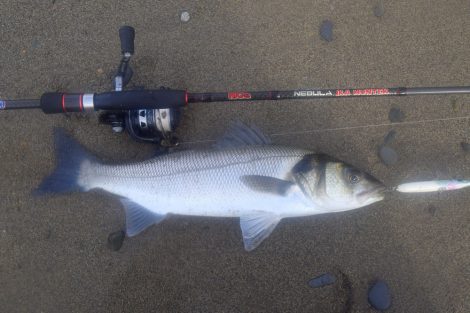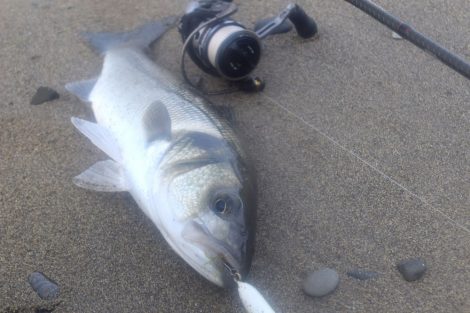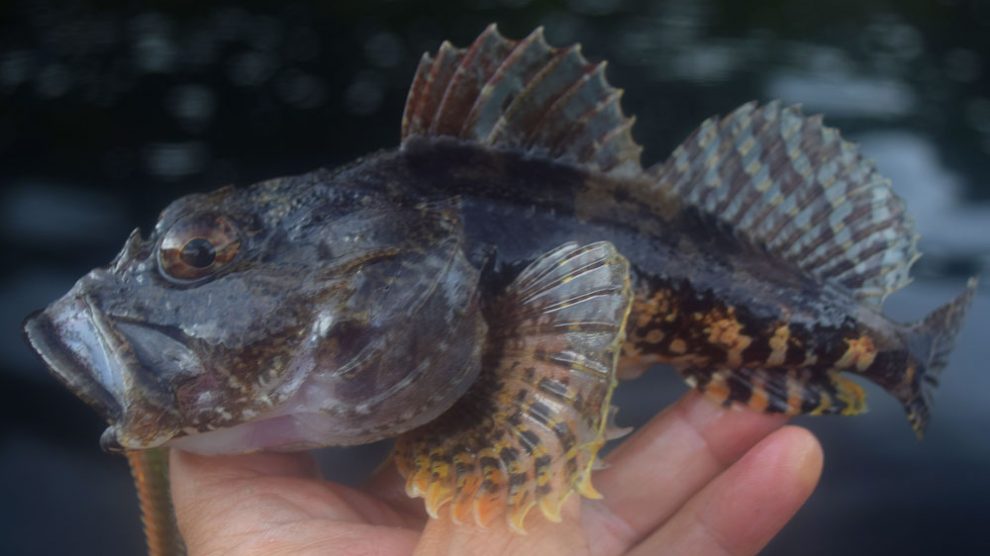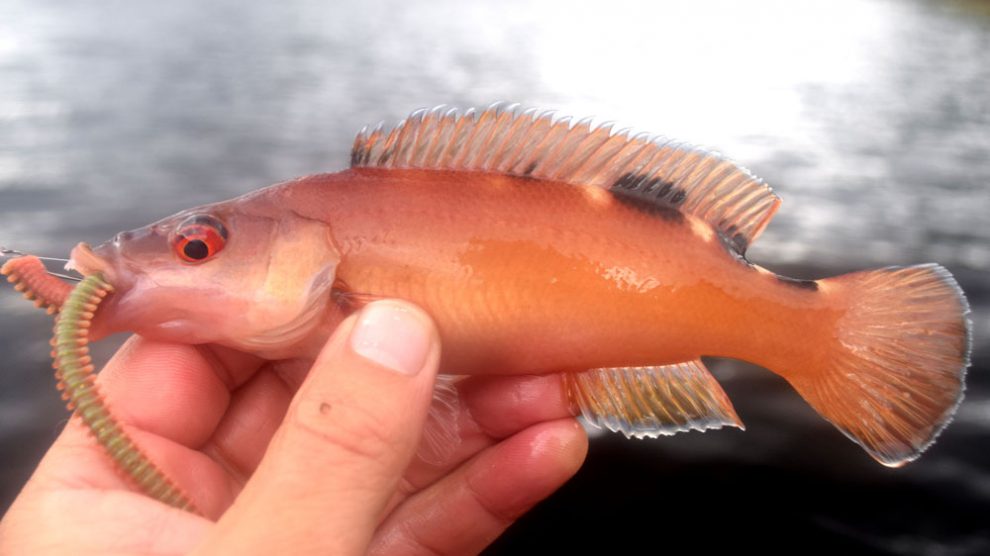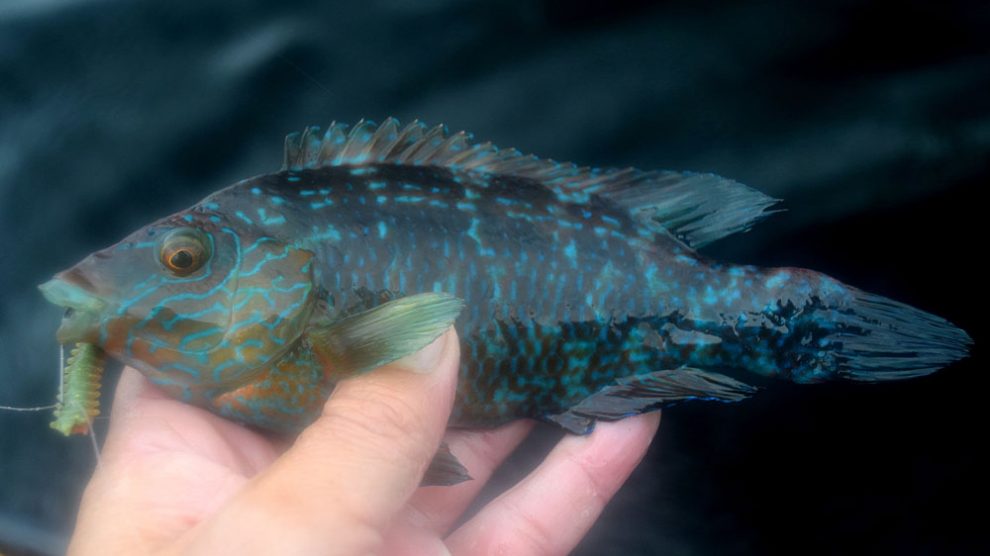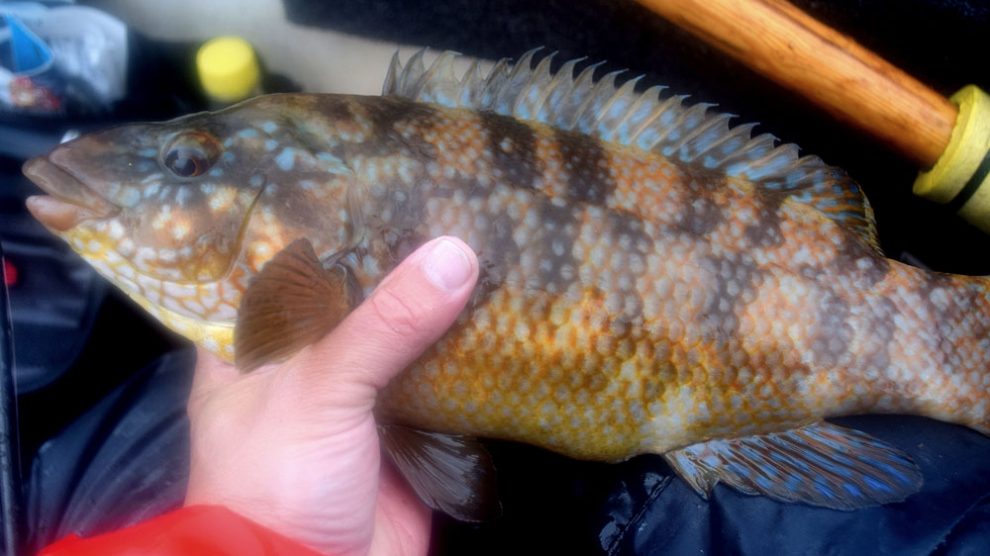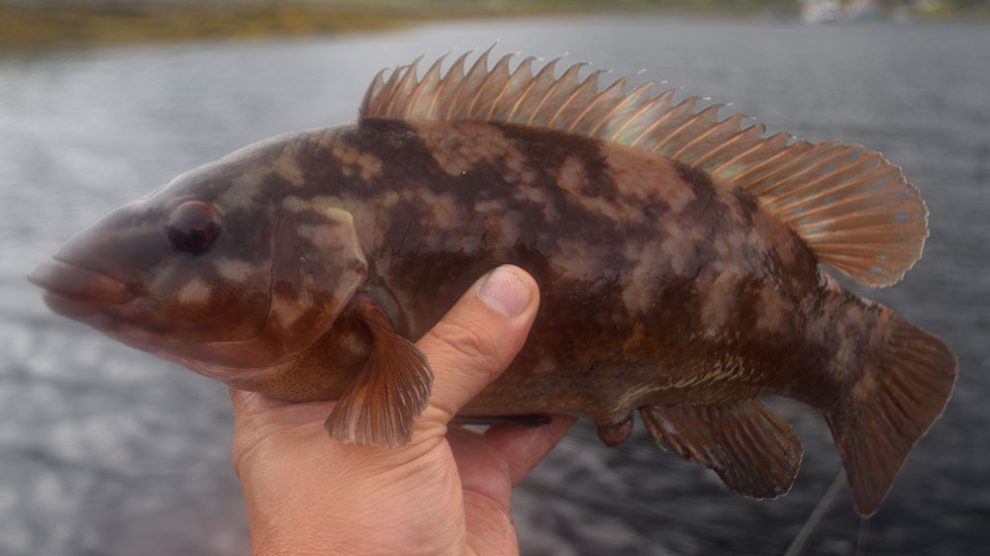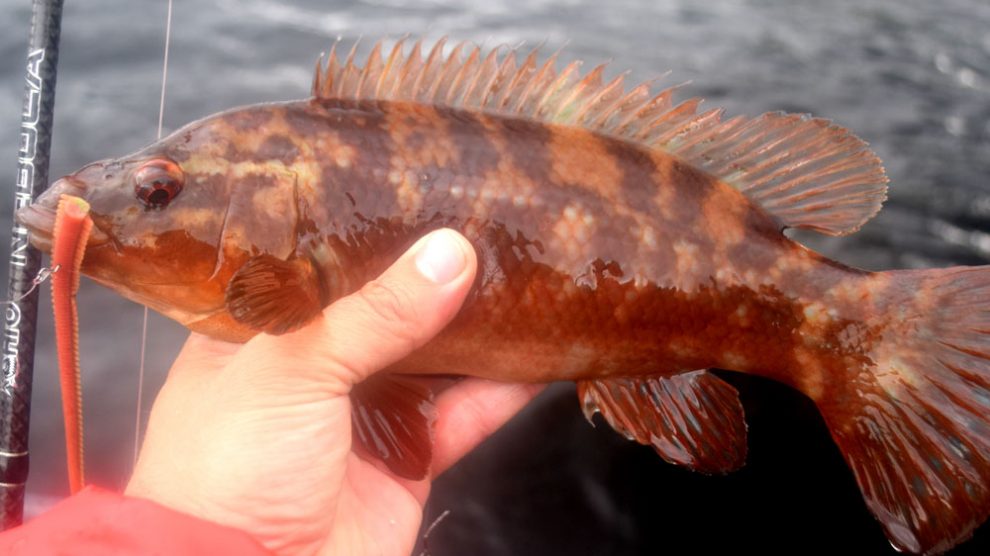July has been a great fishing month for me. Warm, settled weather and loads of fish species to go at means I have been spoiled for choice. In fact, this array of different targets often leads me to bounce wildly from one species to another. However, there are two fish species that have been taking up my time, these being bass and wrasse.
At the start of July, the Schogler household headed southwest to Wales for our annual holiday. Despite being a family holiday, I found lots of time every day to get out and play on the coast. I have recently designed a topwater needlefish style lure, and I was keen to try it out on the Welsh bass.
My bass gear consists of a 3000 size reel loaded with HTO Nebula PE1.2 braid and my favourite bass rod, the HTO Nebula Ika Hunter. For those that follow my writings, you will know how much I rely on this rod for my bass fishing (read my review here). Although it is primarily meant for squid fishing, it makes a simply superb bass fishing rod. It has great sensitivity, handy for feeling your way around the seabed when fishing deep. It also has a fast action, meaning I can work lures very effectively on top or down deep. It has a progressive action which is not noticeable when you are working a lure. However, when you cast, the rod loads up and can ping a lure a country mile with very little effort. The progressive action comes into its own when you hook a fish, beating them very quickly, with the fighting curve sapping the fish's energy extremely effectively.
I was based in North Wales, and most of the marks I fished were shallow, even at high tide. This was a very different challenge to my usual marks on Scotland's east coast, which are deeper and snaggier. This change in underwater terrain meant that my usual tactic of bouncing an HTO Schlugg rigged on a 10g jighead was not the most effective way to fish. Instead, I concentrated on catching bass on top water lures.
Fishing shallow uniform stretches of coast was an interesting challenge, but I was quickly into small school bass. The explosive takes on the surface were something that I enjoyed. The water was gin clear and calm, and usually, I could see the bass storming up towards the lure before seizing it with an electric flash of silver and a big splash.
Although they offered little in the way of a fight, it was intensely visual fishing and gave a fascinating insight into the fishes hunting behaviour. As my time in Wales wore on, I began to hunger for bigger bass, fun though the schoolies were. It wasn't until day six that I finally managed to find one.
At 7 am, I stood above the beach on the promenade. I knew I was a little early for the reef I intended to fish, so I just stood and watched the sea instead of rushing down to fish the area. As I looked up and down the beach, I noticed a small bait fish skipping across the surface and knew something was chasing it. Like a sprinter out of the blocks, I dashed down to where I saw the activity. One very short cast was all it took. The bass smashed the needlefish in about a foot of water and attempted to head back out with the surf. The wonderful tool that is the HTO Ika Hunter soaked up its shallow water cavorting and very quickly wore the fish down. I could slide it onto the beach with a great feeling of achievement. A couple of beauty pics and I released the fish; at last, I could spend some time with the family.
Overall, it was an immensely satisfying few days of fishing that challenged me to step out of my normal fishing routines. Fishing in a flat calm, uniform sea prompted me to rely on current seams and wind lanes to find fish. These very subtle features were one of the key features to find to ensure action, and the majority of bass were to be found here. The other key to catching was the tide state, where most fish were caught in the first couple of hours of the ebb. Discovering these two keys to success meant I could time my fishing sessions to get the most from the stretch of coast I had access to.
By the time I returned to Scotland, I had cured my bass fever. However, my urge to catch ballan wrasse returned with a vengeance!
Two days later, I was 420 miles north of the mark where I caught the bass, back in the wonderful sea lochs on the west coast of Scotland. Compared to the Welsh coastline, the sea loch is a different environment. Steeply shelving, rocky, kelp fringed foreshore plunging into depths of over 100feet within a short cast from the shore.
My favourite way to target these lochs is by using my 10 foot portable. This gives me the ultimate advantage despite fishing within casting distance from the shore. I use my boat to drift with the current, and I can quickly home in on the most likely depths I will find wrasse at.
My setup for boat fishing for wrasse is the same as I would use from the shore. That is my fantastically reliable LRF setup.
This consists of an HTO Nebula Light Gamer 1-7 gram tube tip rod paired with an HTO Aikido reel loaded with Nebula X8 braid in PE 0.6. To this, I attach a 5-foot length of 8lb Nebula fluorocarbon as a leader. This is attached to my braid via a uni-to-uni knot. I use this particular knot to attach all my leaders. It is quick to tie and very rarely lets me down.
My main rig for fishing for wrasse (as many will know) is a simple weedless dropshot rig. I use a #6 slim fine wire offset hook and rig my chosen lure Texas style. This is tied to the leader using a Palomar knot (another extremely reliable knot) with the weight clipped on a foot to 18 inches from the lure.
Once launched, the tactic is to follow the shoreline and search the drop offs for wrasse. Wrasse in the lochs are rarely found deeper than fifty feet and generally from 10 to 30 feet. Using this knowledge helps me quickly home in on the most likely areas.
These depths in the sea loch where the wrasse dwell is snag city! However, this is where my LRF tackle comes into its own. Instead of using overly heavy gear to combat the snags, I use the brilliant sensitivity of the Light Gamer rod to feel around snags. This sensitivity allows me to drag my dropshot weight along the seabed, where the feedback from the weight is delivered directly to my hands. The rod is so sensitive that I can tell when I am working the lure through rock, kelp, soft ground and whatever else is down there. Having the ability to feel what's going on means I can feel snags before I wind into them. This sensitivity, coupled with a weedless lure setup, means I avoid the majority of snags.
After launching, I hugged the shoreline and used the currents in the loch to make a controlled drift along the most likely depths.
My technique is simple but super effective. Using the boat's drift, I drop my rig to the bottom and tighten up to the weight. As the boat drifts, I keep my weight in contact with the bottom, allowing it to trundle along in the current. This gentle trundle of the weight is interspersed with twitches and pauses, allowing the lure to wiggle and squirm as it makes its way across the seabed.
With the sea loch in full summer mode, it hardly took any time before I felt the first electric bites of the local wrasse.
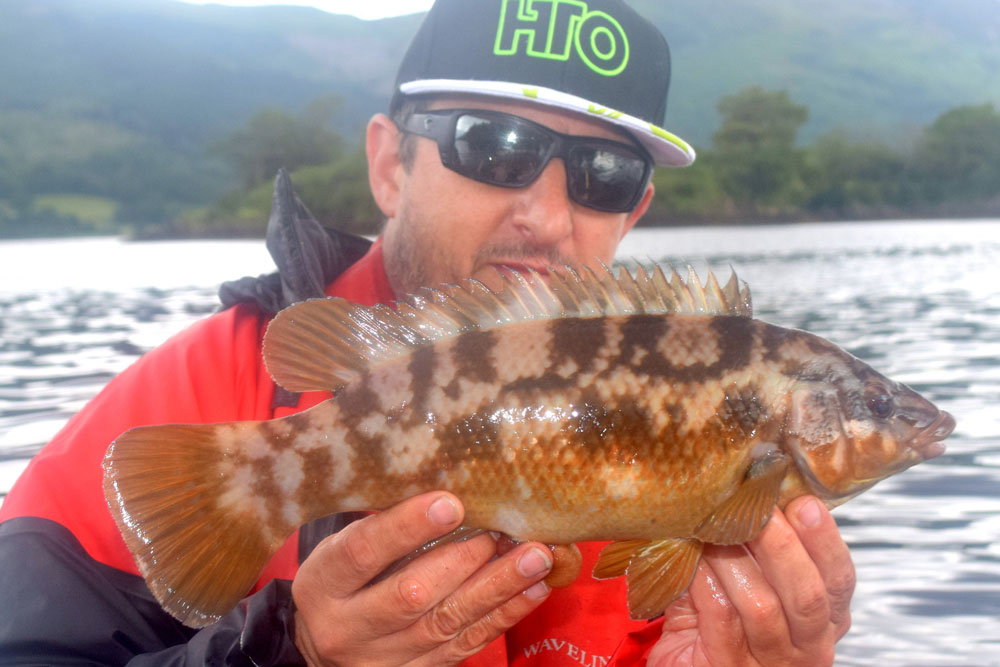
Again, this is where I rely heavily on the rod's sensitivity. These Scottish wrasse very rarely just grab a lure and get hooked. Instead, they seem to follow the lure giving sharp, powerful bites without fully committing. As soon as I feel these bites, I drop the rod tip to give a slight amount of slack line. As the fish bites again, I lift the rod tip very slightly and feel for the weight of the fish. I strike if I feel any weight or an inability to feel the dropshot weight. This usually results in the rod hooping over as an angry wrasse tears off, looking for the sanctuary of snags.
Again, this is where my Light Gamer rod truly shows its qualities. The rod will bend, but despite being such a light, sensitive rod, it harbours a massive amount of power further down the blank. This power is much needed as the wrasse will do all it can to reach any snag it can find. The trick is to hit them and then apply as much pressure as possible to get them up off the bottom and away from the snags. At this point, the power in the rod comes into play as the trick is to hold the wrasse away from the bottom and control their incessant search for freedom. The fights are generally staged, firstly the hit and hold rod bending tussle to get the fish off the deck. Then using the rod to work the fish to the surface slowly. Using the power in the rod to lift the fish up through the water column without rushing allows the wrasse to decompress, which allows the wrasse to get to the surface without “blowing up” from the sudden changes in depth. As I release all wrasse, using my LRF gear helps avoid them being unable to swim back and is yet another reason to use this approach for wrassing.
The wonderful thing about using these techniques is that it's not only wrasse we can catch. Throughout the day, when my boat partner and I were not catching wrasse, we got pollack, poor cod, codling, and scorpion fish from the wrasse grounds. The fun and varied fishing wasn't dampened by the seemingly unstoppable rain of a Scottish summer day.
Throughout the session, we caught lots of good size ballan wrasse, all of which were in amazing condition, thick, powerful and wonderfully coloured. They were the cure to my bass fever.
We ended the day with three species of wrasse, ballan, corkwing and cuckoo, and as I am writing this, a new fever has returned, wrasse, and I can't wait to get back at them.
Tight lines
Jake


